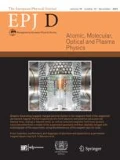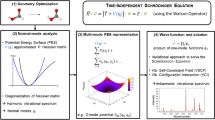Abstract
Mid-infrared spectra of difluoromethane (DFM) have been recorded by confining the molecule in the matrix cages of pure argon, nitrogen and in the mixed matrixes of argon and nitrogen obtained by mixing the two gases in definite proportions. The measured spectra depict distinct confinement effects in terms of the infrared spectral shifts of the C–H and C–F stretching vibrational fundamentals as compared to the free molecules in the gas-phase, and also some remarkable changes in band appearances and relative intensities. The signs of the spectral shifts are observed to be different for the \(\upnu _{\text {C--H}}\) and \(\upnu _{\text {C--F}}\) transitions. Pronounced blue shifts are observed for the two \(\upnu _{\text {C--H}}\) modes in pure nitrogen matrix, which progressively reduce in magnitude in the mixed matrixes, and is least in the pure argon matrix. On the other hand, distinct red shifts of the \(\upnu _{\text {C--F}}\) vibrations are evident in pure nitrogen matrix, which are reduced in magnitude in the mixed matrixes, and become even less pronounced in pure argon matrix. The effect of Fermi resonances in the \(\upnu _{\text {C--H}}\) region, that has motivated several previous investigations of DFM including high resolution gas phase studies, becomes explicit upon comparison of the matrix isolation spectrum with the gas phase spectrum. Electronic structure calculations using several DFT and DFT-D methods, in conjunction with NBO analysis, have been carried out for various sizes of \(\hbox {DFM-N}_{2}\) and DFM-Ar complexes in order to understand the underlying interactions responsible for the observed shifts. The calculations are found to satisfactorily reproduce the observed variations in magnitude and direction of the shifts of both the \(\upnu _{\text {C--H}}\) and \(\upnu _{\text {C--F}}\) transitions for the change of the medium. It is inferred that the inert gas matrix environment exerts an electronic re-organization within the DFM molecule, and the consequent rehybridization of the carbon-centric hybrid orbital of the C–H and C–F bonds is responsible for the observed spectral shifts.
Graphic abstract






Similar content being viewed by others
Data Availability Statement
This manuscript has no associated data or the data will not be deposited. [Authors’ comment: All relevant data on which the conclusions of this work rely are presented in the main manuscript, and hence need not be separately deposited in any data repository.]
References
E.D. Becker, G.C. Pimentel, Spectroscopic studies of reactive molecules by the matrix isolation method. J. Chem. Phys. 25, 224 (1956)
G.M. Munoz Caro, U.J. Meierhenrich, W.A. Schutte, B. Barbier, A. Arcones Segovia, H. Rosenbauer, W.H.-P. Thiemann, A. Brack, J.M. Greenberg, Amino acids from ultraviolet irradiation of interstellar ice analogues. Nature 416, 403 (2002)
G.C. Pimentel, M.O. Bulanin, M.V. Thiel, Infrared spectra of ammonia suspended in solid nitrogen. J. Chem. Phys. 36, 500 (1962)
M. Mukherjee, B. Bandyopadhyay, P. Biswas, T. Chakraborty, Amine inversion effects on the IR spectra of aniline in the gas phase and cold inert gas matrixes. Indian J. Phys. 86, 201 (2012)
T.N. Wassermann, D. Luckhaus, S. Coussan, M.A. Suhm, Proton tunneling estimates for malonaldehyde vibrations from supersonic jet and matrix quenching experiments. Phys. Chem. Chem. Phys. 8, 2344 (2006)
S. Lopes, A.V. Domanskaya, R. Fausto, M. Räsänen, L. Khriachtchev, Formic and acetic acids in a nitrogen matrix: enhanced stability of the higher-energy conformer. J. Chem. Phys. 133, 144507 (2010)
I. Bhattacharya, J. Sadhukhan, S. Biswas, T. Chakraborty, Medium-dependent crossover from the red to blue shift of the Donor’s stretching fundamental in the binary hydrogen-bonded complexes of CDCl3 with ethers and ketones. J. Phys. Chem. A 124, 7259 (2020)
M. Hippler, Quantum chemical study and infrared spectroscopy of hydrogen-bonded CHCl\(_3\)–NH\(_3\) in the gas phase. J. Chem. Phys. 127, 0834306 (2007)
S.L. Paulson, A.J. Barnes, Trihalogenomethane base complexes studied by vibrational spectroscopy in low temperature matrices. J. Mol. Struct. 80, 151 (1982)
I. Suzuki, T. Shimanouch, Vibration-rotation spectra and molecular force field of methylene fluoride and methylene fluoride-d2. J. Mol. Struct. 46, 130 (1973)
S. Kondo, T. Nakanaga, S. Saëki, Infrared intensities and coriolis interactions in methylene fluoride. J. Chem. Phys. 73, 5409 (1980)
R.D. Amos, N.C. Handy, W.H. Green, D. Jayatilaka, A. Willetts, P. Palmieri, Anharmonic vibrational properties of CH2F2: a comparison of theory and experiment. J. Chern. Phys. 95, 8323 (1991)
M.N. Deo, R. Dcunha, V.A. Job, The a2” Forbidden” band in CH2F2: \(\nu \)5–\(\nu \)7 coriolis interaction. J. Mol. Spectrosc. 161, 403 (1993)
T.J. Cronin, X. Wang, G.A. Bethardy, D.S. Perry, High-resolution infrared spectra in the C–H region of CH2F2: the \(\nu \)6 and 2\(\nu \)2 bands. J. Mol. Spectrosc. 194, 236 (1999)
K.M. Smith, G. Duxbury, D.A. Newnham, J. Ballard, A high-resolution analysis of the n3 and n9 absorption bands of difluoromethane. J. Mol. Spectrosc. 193, 166 (1999)
M.N. Deoa, K. Kawaguchib, R. D’Cunhaa, High-resolution FTIR study of the \(\nu \)2 band of CH2F2 and coriolis interaction between the \(\nu \)2 and \(\nu \)8 states. J. Mol. Struct. 517, 187 (2000)
H. Jiang, D. Appadoo, E. Robertson, D. McNaughton, A comparison of predicted and experimental vibrational spectra in some small fluorocarbons. J Comput. Chem. 23, 1220 (2002)
N. Tasinato, G. Regini, P. Stoppa, A.P. Charmet, A. Gambi, Anharmonic force field and vibrational dynamics of CH\(_2\)F\(_2\) up to 5000 cm\(^-1\) studied by Fourier transform infrared spectroscopy and state-of-the-art ab initio calculations. J. Chem. Phys. 136, 214302 (2012)
P. Stoppa, N. Tasinato, A. Baldacci, A.P. Charmet, S. Giorgianni, F. Tamassia, E. Cané, M. Villa, FTIR spectra of CH\(_2\)F\(_2\) in the 1000–1300 cm\(^-1\) region: rovibrational analysis and modelling of the coriolis and anharmonic resonances in the \(\nu \)3, \(\nu \)5, \(\nu \)7, \(\nu \)9 and 2\(\nu \)4 polyad. J. Quant. Spectrosc. Radiat. Transf. 175, 8 (2016)
N. Tasinato, G. Ceselin, A.P. Charmet, P. Stoppa, S. Giorgianni, Line-by-line spectroscopic parameters of HFC-32 ro-vibrational transitions within the atmospheric window around \(8.2\mu \text{ m }\). J. Mol. Spec. 348, 57–63 (2018)
N. Tasinato, A. Turchetto, C. Puzzarini, P. Stoppa, A.P. Charmet, S. Giorgianni, Self-, \(\text{ N}_{2}\)-, \(\text{ O}_{2}\)-broadening coefficients and line parameters of HFC-32 for \(\nu _{7}\) band and ground state transitions from infrared and microwave spectroscopy. Mol. Phys. 112, 2384–2396 (2014)
N. Tasinato, What are the spectroscopic properties of HFC-32? Answers from DFT. Int. J. Quantum Chem. 114, 1472–1485 (2014)
I.S. Sosulin, D.A. Tyurin, V.I. Feldman, A hydrogen-bonded CH\(_2\)F\(_2\)\(\cdots \)CO complex: ab initio and matrix isolation study, Author links open overlay panel. J. Mol. Struct. 1221, 128784 (2020)
P. Banerjee, T. Chakraborty, Weak hydrogen bonds: insights from vibrational spectroscopic studies. Int. Rev. Phys. Chem 37, 83–123 (2018)
A. Allerhand, P.R. Schleyer, Solvent effects in infrared spectroscopic studies of hydrogen bonding. J. Am. Chem. Soc. 85, 371 (1963)
A.R.H. Cole, L.H. Little, A.J. Michell, Solvent effects in infra-red spectra. O–H and S–H stretching vibrations. Spectrochim. Acta 21, 1169 (1965)
R. Fraenkel, Y. Hass, Molecular dynamics simulations of rare gas matrix deposition. Chem. Phys. 186, 185 (1994)
X.J. Ning, Q. Qin, A new molecular dynamics method for simulating trapping site structures in cryogenic matrices. J. Chem. Phys. 110, 4920 (1999)
T. Talik, K.G. Tokhadze, Z. Mielke, Infrared spectra and molecular dynamics simulations of cis-HONO isomer in an argon matrix. J. Mol. Struct. 611, 95 (2002)
F. Ito, Modelling and spectral simulation of formic acid dimer in Ar matrix using ONIOM calculations. Comput. Theor. Chem. 1161, 18 (2019)
K.V. Jovan Jose, S.R. Gadre, K. Sundararajan, K.S. Viswanathan, Effect of matrix on IR frequencies of acetylene and acetylene-methanol complex: infrared matrix isolation and ab initio study. J. Chem. Phys. 127, 104501 (2007)
C.A. Rice, N. Borho, M.A. Suhm, Dimerization of pyrazole in slit jet expansions. Z. Phys. Chem. 219, 379–388 (2005)
V. Tabacik, V. Pellegrin, H.H. Günthard, Infrared gas and matrix spectra of all eight symmetrical deutero pyrazole monomers. Spectrochim. Acta Part A 35, 1055 (1979)
P. Banerjee, T. Chakraborty, Correlation of \(\nu _{{\rm OH}}\) spectral shifts of phenol–benzene O–H\(\cdots \pi \) hydrogen-bonded complexes with Donor’s acidity: a combined matrix isolation, infrared spectroscopy, and quantum chemistry study. J. Phys. Chem. A 118, 7074 (2014)
P. Banerjee, D.P. Mukhopadhyay, T. Chakraborty, On the origin of donor O–H bond weakening in phenol-water complexes. J. Chem. Phys. 143, 204306-1-9 (2015)
Frisch et al., Gaussian 09, Revision C.01 (Gaussian, Inc., Wallingford, 2010)
Y. Zhao, D. Truhlar, The M06 suite of density functionals for main group thermochemistry, thermochemical kinetics, noncovalent interactions, excited states, and transition elements: two new functionals and systematic testing of four M06-class functionals and 12 other functionals. Theor. Chem. Acc. 120, 215 (2008)
S. Grimme, Density functional theory with London dispersion corrections. WIREs Comput. Mol. Sci. 1, 211 (2011)
S. Grimme, Semiempirical GGA-type density functional constructed with a long-range dispersion correction. J. Comput. Chem. 27, 1787–99 (2006)
S.F. Boys, F. Bernardi, The calculation of small molecular interactions by the differences of separate total energies: some procedures with reduced errors. Mol. Phys. 19, 553 (1970)
A.E. Reed, L.A. Curtiss, F. Weinhold, Intermolecular interactions from a natural bond orbital, donor–acceptor viewpoint. Chem. Rev. 88, 899 (1988)
D.F. Dinu, B. Ziegler, M. Podewitz, K.R. Liedl, T. Loerting, H. Grothe, G. Rauhut, The interplay of VSCF/VCI calculations and matrix-isolation IR spectroscopy—mid infrared spectrum of \(\text{ CH}_{3}\text{ CH}_{2}\text{ F }\) and \(\text{ CD}_{3}\text{ CD}_{2}\text{ F }\). J. Mol. Spec. 367, 111224 (2020)
P. Seidler, J. Kongsted, O. Christiansen, Calculation of vibrational infrared intensities and Raman activities using explicit anharmonic wave functions. J. Phys. Chem. A 111, 11205–11213 (2007)
I.V. Alabugin, M. Manoharan, S. Peabody, F. Weinhold, The electronic basis of improper hydrogen bonding: a subtle balance of hyperconjugation and rehybridization. J. Am. Chem. Soc. 125, 5973–5987 (2003)
I. Lefkowitz, K. Kramer, M.A. Shields, G.L. Pollack, Dielectric and optical properties of crystalline argon. J. Appl. Phys. 38, 4867–4873 (1967)
Acknowledgements
The authors acknowledge the financial support received from the Department of Science and Technology, Government of India and partial support from the grant of the CSIR in carrying out the research. PB acknowledges Dr. Biman Bandyopadhyay for technical assistance.
Author information
Authors and Affiliations
Corresponding author
Additional information
Atoms and Molecules in a Confined Environment—edited by C. N. Ramachandran, Vincenzo Aquilanti, Henry Ed Montgomery, N. Sathyamurthy.
Rights and permissions
About this article
Cite this article
Banerjee, P., Chakraborty, T. Confinement effects on C–H and C–F stretching vibrational frequencies of difluoromethane in cold inert gas matrixes: a combined infrared spectroscopy and electronic structure theory study. Eur. Phys. J. D 75, 131 (2021). https://doi.org/10.1140/epjd/s10053-021-00142-3
Received:
Accepted:
Published:
DOI: https://doi.org/10.1140/epjd/s10053-021-00142-3




